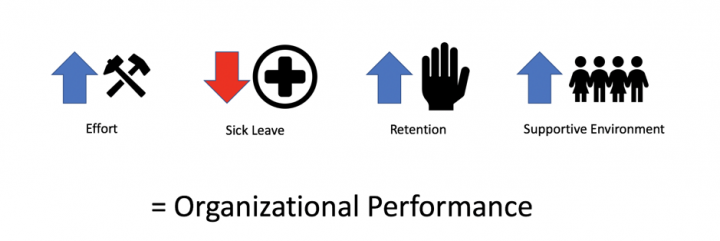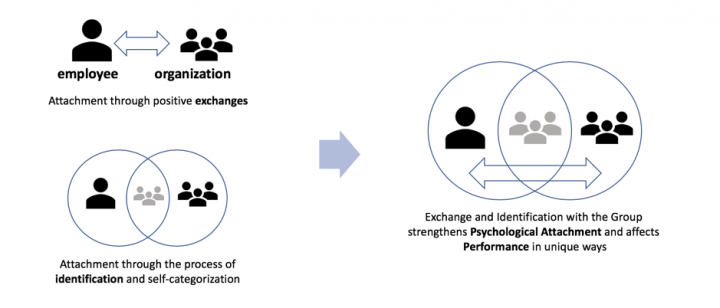How to improve employee loyalty in a rapidly changing and digitized workplace
In today’s fast-moving and highly competitive business environment, organizations are looking for new ways to implement and utilize resources strategically to increase organizational value and to achieve a firm-level competitive advantage. However, due to the changing nature of work, the role human resources play in the value creation process of organizations is changing. There is an increasing war for talent—especially for those who have the skillset and the mindset to succeed in today’s workplace. Strategic talent management is therefore a determining factor for organizational effectiveness and for ensuring one’s competitiveness in the marketplace. An organization’s ability to attract and retain talent is becoming increasingly important for its survival.
At the same time, there is a decreasing sense of loyalty from both the employer’s side as well as from the employee’s side in today’s dynamic business environment. Organizational practices, which were once effective in attracting and engaging employees, are steadily losing ground and need to be re-evaluated and re-tested to maintain effectiveness in today’s changing nature of work. Investigating the psychological mechanisms underlying work attachment, such as the concept of organizational commitment, can provide powerful insights on how to better connect and engage employees in a rapidly changing work environment.


What is organizational commitment?
Organizational commitment has been defined as a psychological bond that one feels towards an organization. It’s a driving force of work behavior. Commitment towards the organization can come in different forms, such as an emotional attachment one feels toward the organization reflecting one’s desire to work for a company. Commitment towards the organization can also be calculative by nature, which means that you decide to stay in the organization because you have been with the company for so many years and have accrued certain benefits… or maybe because you see no better alternative elsewhere. Finally, people also feel morally committed to stay with an organization. Maybe because of their personal work values or because they feel that staying is a requirement to pay back received benefits from the organization. Positive work exchanges within the employee–employer relationship help develop commitment toward the organization. This is often referred to as the social exchange basis of attachment.
So, what do these exchanges reflect within the employee–employer relationship? When an employee provides his or her time and effort to the organization, it is expected to be reciprocated with transactional and relational commodities such as pay, recognition, and support from the organization. This exchange relationship is governed through something that is called the psychological contract, which evaluates if mutual obligations are being met. The outcome of a perceived balanced and fair psychological contract is commitment towards the organization.
The importance of organizational commitment for value creation
Research has repeatedly shown that employees with high organizational commitment exert more effort on the job, are less sick and absent from work, are more willing to stay with their employer, and contribute to the social and psychological environment of the organization. Enhancing organizational commitment is important to improve productive work behaviors that have a positive impact on organizational performance.
Dynamic forces are shaping where and how we work. The usage of autonomous devices is transforming mobility and the transportation of goods. Workplaces are transcending the physical premises of organizations. Robotization is rapidly replacing manual production and precision work. And digitalization is facilitating work interactions and communication across the globe. We no longer all share the same workplace, the same teams, the same time zones, or even the same working conditions or contracts. It’s clear that the nature of work is changing and more effort from the individual employee is expected to adapt to this change. It’s becoming increasingly difficult for organizations to provide work environments that are perceived as balanced, fair, and supportive, which is so fundamental to the development of organizational commitment. So, the main leadership question for many organizations today is, “How do we create a committed workforce in a dynamic workplace?”


Creating a more durable mindset of commitment though IDENTITY
It is clear from the above that organizational commitment, based on social exchanges alone, is not strong enough to connect and engage employees in today’s workforce. A new attachment mechanism needs to be sought that is robust enough to connect people in a rapidly changing and digitalized work environment. My research over the past six years has investigated the psychological mechanisms underlying work attachment to discover new ways of enhancing organizational commitment in today’s workplace. This led to the creation of the Employee Connect Model (ECM). This model uses social identity as a key attachment mechanism to foster organizational commitment.
Social identity within organizations is often referred to as organizational identification and posits that a sense of oneness and belongingness is created through one’s identification with the organization. This means that being a member of an organization triggers individual cognitions of self and allows for the internalization of group values, norms, and other characteristics into one’s self-concept. And this in turn promotes individual behaviors favoring the organization. High identification with an organization leads to a sense of belongingness, pride, self-esteem, and a sense of security in uncertain times. Attachment through identification is very resilient as it shapes the identity of the employee and influences individual perceptions and work behaviors (e.g. to benefit the welfare of the organization). Research findings suggest that ECM is able to effectively attach and engage employees working in shorter and more flexible work agreements, virtual and remote work setups, and multi-cultural teams.
ECM, based on both social exchange and social identity processes, helps to understand how to foster employee attachment in a rapidly changing work environment and promises to be a more resilient model of organizational commitment.


How do you use IDENTITY at work to build an attached and engaged workforce?
ECM provides practical insights and tools for engaging and connecting employees in today’s workplace. Here follow a couple of practical examples of how to apply ECM at work:
Organizational values & identity leadership
Values are core to organizations—just as they are core to human beings. Values are a cognitive representation of our needs and beliefs. To a strong extent they influence individual behavior, judgement, and decision making. Organizational values and culture are often referred to as the glue that keeps people together and should be reflected throughout the organization: policies, procedures, reward systems, stories, customer orientation. Leaders and managers play a pivotal role in facilitating this alignment. As an organizational leader, it is absolutely vital to be able to communicate the values and the purpose of the organization, which helps followers connect and engage and understand the “why?” behind work.
Identity leadership is pivotal in connecting employees to a common goal and purpose, while at the same time allowing for individual identities to flourish. Identity leadership helps connect employees to core values, organizational norms, meaningful work, brand, and reputation. To be able to do this, findings from this research indicate that leaders need to develop a strong reflective mindset to help understand who they are and how they impact others, and also understand the different identities at work and how these can be influenced and leveraged to benefit the overall organization. In other words, leaders need to develop behavioral and psychological skills to effectively lead themselves and their organizations in a rapidly changing environment.
“Empirical research shows that by leveraging individual and group identities, leaders and managers will be in a better position to connect people working in and outside the organization, help people shape reality, and finally drive behavior in a common direction.”
Job roles
Everyone has multiple identities. The different identities we show throughout the day (e.g. father, team leader, entrepreneur, environmentalist, religious) affects our thinking and behavior in different ways. This is the same at work. Work identities can have a strong effect on work attitudes and behaviors. Being called a “Barista” instead of a “Coffee Maker” can significantly affect how you behave at work and interact with customers, and even who you associate with. It also helps you to understand who is and is not a “Barista,” which creates group promoting and protective behaviors (in versus out group). Triggering individual and group identities at work can help enhance a “WE” perspective on the job, which enhances the social and psychological environment of the organization and improves task performance and employee wellbeing. My research shows that strong social identities at work motivate individual employees to favor group goals over personal goals, benefiting the welfare of the organization.


Organizational on-boarding
One of the key findings from my research is the susceptibility of employees to new work experiences or uncertain conditions, such as when starting a new job or being promoted. These uncertain work experiences activate work cognitions that are sensitive to both social exchange- and social identity-based work experiences. These findings indicate that formative work experiences or work socialization, such as the on-boarding of new employees, should be carefully designed. Effective employee on-boarding is fundamental in developing strong identity- and exchange-based relationships that promote attachment and engagement behaviors. Additional attention to employee experiences in the beginning can have long-lasting positive effects to organizational performance.


Conclusion
Effectively applying the Employee Connect Model, based on both social exchange and social identity, provides a more resilient approach to commitment development in the workplace. ECM helps organizational leaders and (HR) managers effectively attract, engage, and retain talent in a rapidly changing and highly competitive business environment. Research findings provide valuable insights into how to influence the employee-employer relationship from a psychological perspective and inform how to actively steer employee and organizational performance through identity leadership.
More like this
Watch Ali’s TEDx talk on Reflective Mindset
Why is social media so addictive?




